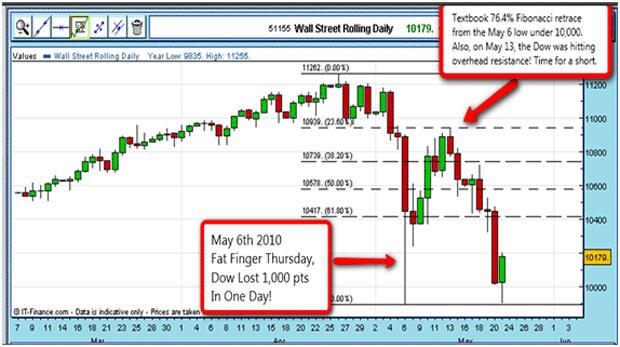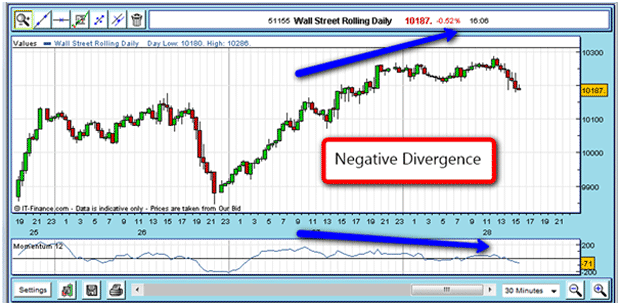Spread Betting Strategy 2 – Trading Market Reversals
This strategy requires a lot more skill – and it may be some time before you can master it. But please don’t give up – the potential rewards are massive. Trend – following methods can give you a series of small-to-medium sized wins (and losses) most of the time, and is akin to a war of attrition with the markets, where you take a series of small-medium profits gradually over many trades (with the small losses included).
On the other hand, if you trade the reversals, you can occasionally expect some very big home runs as you catch the bottom (or top) of what turns out to be a very big move. This is the Holy Grail for professional traders.
I must warn you that trading reversals can be dangerous. One of the oldest pieces of received wisdom is that you should never try to pick lows or highs.
‘Picking bottoms is like trying to catch a falling knife’.
This advice usually is given by traders who have not met Mr Fibonacci or Mr Elliott (more later). With that warning in mind, let’s have a look at how to make big profits by trading market reversals.
Trading A Reversal When The Market Has Retraced
Let’s say the FTSE has been in a clear uptrend for some time (weeks and months). It then runs out of steam, and begins to fall under profit-taking and new short-selling. It then finds support and begins to rally again and begins a retracement of the fall. This is where Mr Fibonacci earns his keep!
If, from further technical analysis, we have strong reasons that the rally will not get back to the old high, we can apply a Fibonacci scale (available in any spread trading platform) using the low of the dip as one anchor point and the old high as the other anchor point.
The retracement rally will likely stop at one of the major Fibonacci levels, and then reverse. We can then place our sell order close to this level (and place a protective stop) and voila! – the market reverses right on cue! It’s magic. Our order can be a limit order, since we know at what price we wish to enter. It may not be filled right away, but if the market makes it to the Fibonacci retracement level, it will eventually. Obviously, this does not happen in every case!
Here is a great example in the Dow Jones which reversed down May 15th 2010 from a massive Fibonacci retracement rally. A short trade at the 10,940 area (a Fibonacci 76.4% level!) would have produced at £1,150+ profit if covered May 25th on just a £1 bet.

This shows the tremendous profit potential of this strategy. If you can catch a few of these home runs a year, and keep your losses within bounds, you should be making good profits every year – with no net losses. That is where the Discipline I mentioned earlier comes in.
This is also the essence of Swing Trading – catching the largest part of major swings. There is a whole industry around swing trading, and that is what I do most of the time.
As a confirming indicator that a reversal is imminent, I look at the behaviour of the Momentum Oscillator.
As an example, look at this chart of the Dow Jones on a short time-frame. I am looking to short the market and see that on the rally, the momentum was getting weaker and weaker. In this situation, I place my sell-stop just under a recent significant low – in this case the 10185 level.

The main trend is down, so I am really trading with the main trend, but against the short-term trend.
My sell-stop is hit, and the market duly returns to the downtrend. Of course, I place a protective buy-stop just above my entry, in case I am wrong (we must always allow for this eventuality, no matter how convinced we are that the trade will give us a profit – we are working with probabilities)
Order Entry Method With This Strategy
If looking to short an uptrend (as in the above example), place your sell-stop just below the most recent significant low.
If looking to buy in a downtrend, place your buy-stop just above the most recent high.
The term ‘most significant high/low’ is a little subjective, but a glance at the chart in the same time-frame you are trading in should reveal all. Many ‘lows’ that show up clearly on a 10-minute chart are just not visible on a daily chart, for instance.
As the market moves in your favour, you can move protect-profit stops towards the market, as described earlier. Or, you may have a specific target in mind where you would like to take profits. This is where it starts to get interesting.
Managing Your Open Gains – How To Take Profits
Remember, a gain is just that – but a profit is a banked gain. There are two methods: Being taken out by moving your trailing protect-profit stop, or having a target and letting your limit order take you out. Of course, you will make a bigger profit with the second, but each has its own drawbacks:
- Being taken out by your trailing stop means you will not get out at the very top (if long), or bottom (if short). But you will get out with a profit.
- Hitting your target is great, but the market may go even further and if you were using a trailing stop, that would make a larger profit! Also, if the market does not reach your target, your gains are reduced (but always use a trailing stop even with this method).
There is no clear-cut better way, but at least you know the options for you to make a choice which fits in with your trading style.
Trading A Reversal When The Market Is In New High/Low Ground
Wouldn’t we all have loved to buy Gold at its low at $255 in 2001 just as a certain Mr Brown was selling his (ours, if you are a UK taxpayer), right at the end of one of the longest bear markets in financial history (from 1980 to 2001, in fact)? But what if we were early and bought it at $350 (thinking it was great value)? We would not be as happy. As in life, timing is everything. I hope that is one of the main messages you take from this spread betting guide.
Are there any tools can we employ to give us an edge when it comes to timing a change in trend? This brings us to the two gentlemen mentioned: Messrs. Fibonacci and Elliott. No, they are not a vaudeville act, but two of the greatest influences in technical analysis in history. I’ll go into why larter, but first, I want to dispel some myths.


Join the discussion